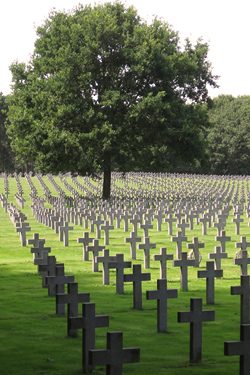Kurt W tzel
 | Sch tze 6./IR.456 14 juli 1919 [14.07.1919] Geboortedatum: Sandersdorf Geboorteplaats: 10 mei 1940 [10.05.1940] Overlijdensdatum: IJsselsteyn Begraafplaats: EKM: 1./Ers.Btl.11 Functie: |
Notities
- IR.481 leidde de aanval op het wegenknooppunt Mill, een sleutelpositie in de Peel-Raamstelling. III./IR.481 was aan boord van de gepantserde goederentrein die achter de Panzerzug door de stelling reed en nabij halte Zeeland ontlaadde. De overige twee bataljons werden als eerste bij Gennep over de Maas gebracht via de veroverde spoorbrug en stootten door naar het dorpje Mill. Zij kwamen vanaf de middag van 10 mei 1940 in gevecht met de vasthoudende Nederlandse defensie bij Mill. Pas laat in de middag kwam IR.456 ter ondersteuning in de sector aan. Gezamelijk werd de avondaanval ingezet, die uiteindelijk mede wegens een zwaar luchtbombardement leidde tot de Duitse doorbraak van de Peel-Raamstelling in de sector Mill - Langenboom - Zeeland. De exacte Duitse verliescijfers vari ren sterk per bron.
- Moet tijdens de avondaanval zijn gesneuveld. Voordien was alleen 3.(Radf.)/IR.456 actief geworden. De aanval van IR.456 liep min of meer vast op de Nederlandse defensie.
- IR.481 formed the most forward element of 256.ID during the offensive against the main Dutch defence-line (Peel-Raam) at the village Mill, that formed a strategic infrastructural point in the area. The German battalion III./IR.481 was on board of the armoured personnel train that followed the armoured train (Panzerzug no.1) when both Maas- and Peel-Raamline were penetrated by these trains in the early morning of May 10, 1940. The battalion was offloaded about two km behind the Dutch defence-line at Mill, and soon developed against the Dutch positions near the canal and railway line. The other two battalions of the regiment followed later, the traditional way, after crossing the intact Gennep bridge across the Maas. They arrived near Mill around noon. Only late in the afternoon the second regiment, IR.456, joint the already fully engaged IR.481 in battle. After an extensive Luftwaffe raid on the Dutch defences just before dawn, both regiments engaged the Dutch defences in a full scale offensive manoeuvre and eventually managed to push the Dutch aside and breach the main defences in the triangle Mill - Langenboom - Zeeland. It wasn't until 11 May in the late morning before all resistance had been cleared. The exact total number of German casualties is unclear, due to conflicting evidence
- Must have been killed in the late evening when the large offensive move against the Dutch defences was unleashed. Before only 3.(Radf.)/IR.456 had become active. IR.456's attack basically ran aground on the Dutch defences.

